Public Health Intelligence Report
VerifiedAdded on 2020/12/29
|7
|2391
|493
Report
AI Summary
This report critically analyzes a randomized controlled trial investigating the effectiveness of an intervention designed to improve mother-infant relationships and infant attachment in a socioeconomically deprived community in South Africa. The report examines the study's objectives, design, participants, interventions, outcomes, and results, providing a comprehensive evaluation of the intervention's impact on maternal depression, infant attachment, and mother-infant interaction.
Contribute Materials
Your contribution can guide someone’s learning journey. Share your
documents today.
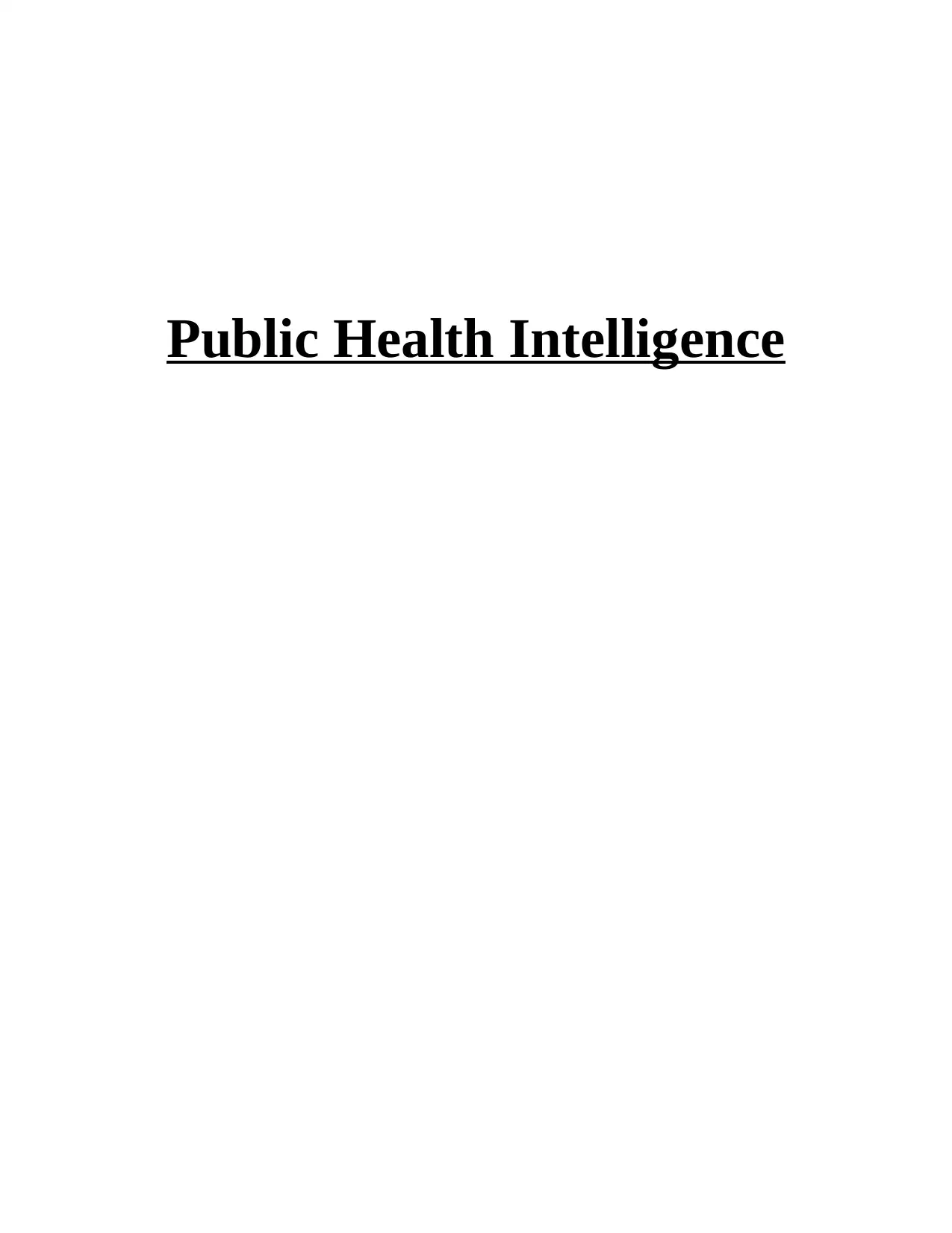
Public Health Intelligence
Secure Best Marks with AI Grader
Need help grading? Try our AI Grader for instant feedback on your assignments.

Table of Contents
CRITICAL ANALYSIS .................................................................................................................3
REFERENCES................................................................................................................................2
CRITICAL ANALYSIS .................................................................................................................3
REFERENCES................................................................................................................................2
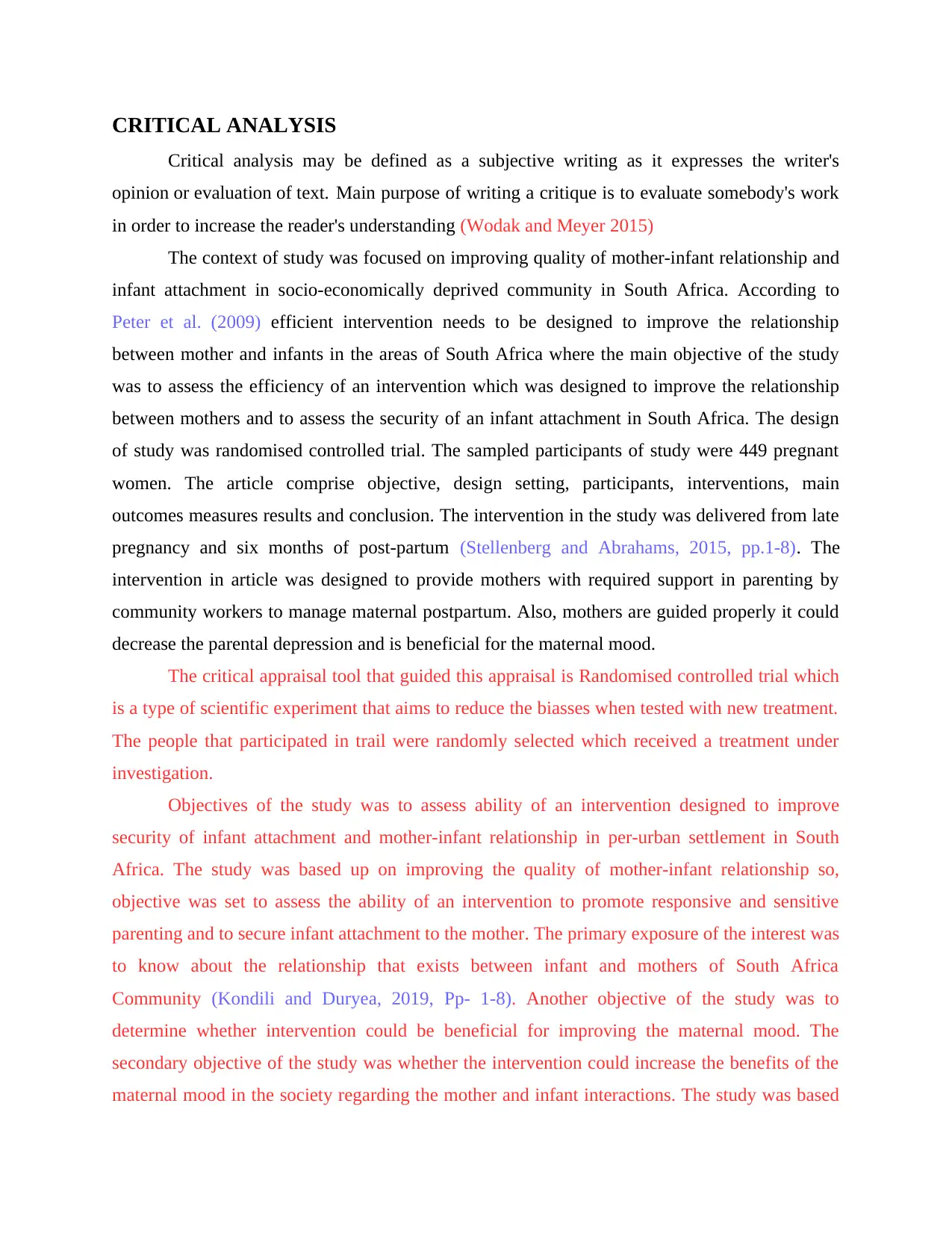
CRITICAL ANALYSIS
Critical analysis may be defined as a subjective writing as it expresses the writer's
opinion or evaluation of text. Main purpose of writing a critique is to evaluate somebody's work
in order to increase the reader's understanding (Wodak and Meyer 2015)
The context of study was focused on improving quality of mother-infant relationship and
infant attachment in socio-economically deprived community in South Africa. According to
Peter et al. (2009) efficient intervention needs to be designed to improve the relationship
between mother and infants in the areas of South Africa where the main objective of the study
was to assess the efficiency of an intervention which was designed to improve the relationship
between mothers and to assess the security of an infant attachment in South Africa. The design
of study was randomised controlled trial. The sampled participants of study were 449 pregnant
women. The article comprise objective, design setting, participants, interventions, main
outcomes measures results and conclusion. The intervention in the study was delivered from late
pregnancy and six months of post-partum (Stellenberg and Abrahams, 2015, pp.1-8). The
intervention in article was designed to provide mothers with required support in parenting by
community workers to manage maternal postpartum. Also, mothers are guided properly it could
decrease the parental depression and is beneficial for the maternal mood.
The critical appraisal tool that guided this appraisal is Randomised controlled trial which
is a type of scientific experiment that aims to reduce the biasses when tested with new treatment.
The people that participated in trail were randomly selected which received a treatment under
investigation.
Objectives of the study was to assess ability of an intervention designed to improve
security of infant attachment and mother-infant relationship in per-urban settlement in South
Africa. The study was based up on improving the quality of mother-infant relationship so,
objective was set to assess the ability of an intervention to promote responsive and sensitive
parenting and to secure infant attachment to the mother. The primary exposure of the interest was
to know about the relationship that exists between infant and mothers of South Africa
Community (Kondili and Duryea, 2019, Pp- 1-8). Another objective of the study was to
determine whether intervention could be beneficial for improving the maternal mood. The
secondary objective of the study was whether the intervention could increase the benefits of the
maternal mood in the society regarding the mother and infant interactions. The study was based
Critical analysis may be defined as a subjective writing as it expresses the writer's
opinion or evaluation of text. Main purpose of writing a critique is to evaluate somebody's work
in order to increase the reader's understanding (Wodak and Meyer 2015)
The context of study was focused on improving quality of mother-infant relationship and
infant attachment in socio-economically deprived community in South Africa. According to
Peter et al. (2009) efficient intervention needs to be designed to improve the relationship
between mother and infants in the areas of South Africa where the main objective of the study
was to assess the efficiency of an intervention which was designed to improve the relationship
between mothers and to assess the security of an infant attachment in South Africa. The design
of study was randomised controlled trial. The sampled participants of study were 449 pregnant
women. The article comprise objective, design setting, participants, interventions, main
outcomes measures results and conclusion. The intervention in the study was delivered from late
pregnancy and six months of post-partum (Stellenberg and Abrahams, 2015, pp.1-8). The
intervention in article was designed to provide mothers with required support in parenting by
community workers to manage maternal postpartum. Also, mothers are guided properly it could
decrease the parental depression and is beneficial for the maternal mood.
The critical appraisal tool that guided this appraisal is Randomised controlled trial which
is a type of scientific experiment that aims to reduce the biasses when tested with new treatment.
The people that participated in trail were randomly selected which received a treatment under
investigation.
Objectives of the study was to assess ability of an intervention designed to improve
security of infant attachment and mother-infant relationship in per-urban settlement in South
Africa. The study was based up on improving the quality of mother-infant relationship so,
objective was set to assess the ability of an intervention to promote responsive and sensitive
parenting and to secure infant attachment to the mother. The primary exposure of the interest was
to know about the relationship that exists between infant and mothers of South Africa
Community (Kondili and Duryea, 2019, Pp- 1-8). Another objective of the study was to
determine whether intervention could be beneficial for improving the maternal mood. The
secondary objective of the study was whether the intervention could increase the benefits of the
maternal mood in the society regarding the mother and infant interactions. The study was based
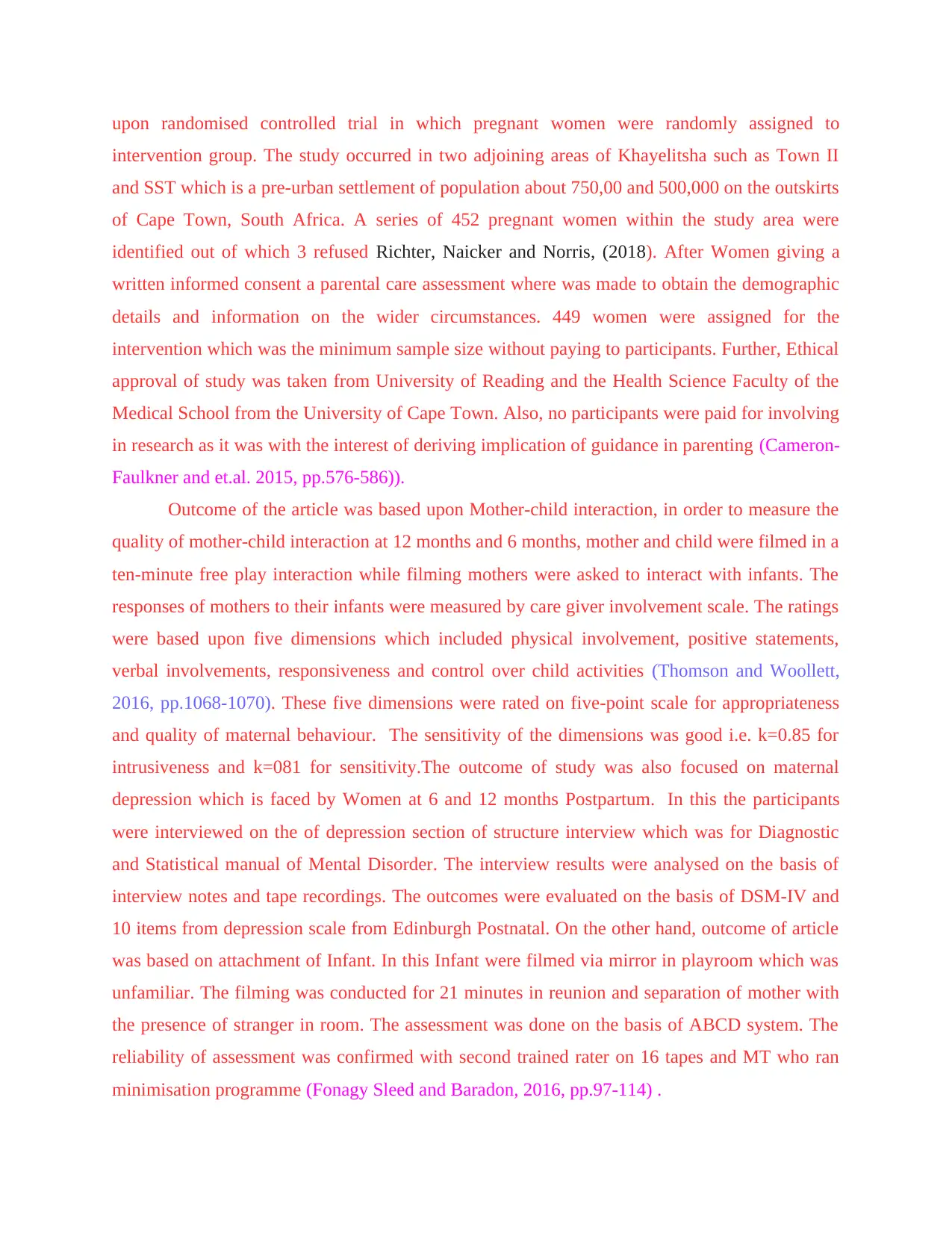
upon randomised controlled trial in which pregnant women were randomly assigned to
intervention group. The study occurred in two adjoining areas of Khayelitsha such as Town II
and SST which is a pre-urban settlement of population about 750,00 and 500,000 on the outskirts
of Cape Town, South Africa. A series of 452 pregnant women within the study area were
identified out of which 3 refused Richter, Naicker and Norris, (2018). After Women giving a
written informed consent a parental care assessment where was made to obtain the demographic
details and information on the wider circumstances. 449 women were assigned for the
intervention which was the minimum sample size without paying to participants. Further, Ethical
approval of study was taken from University of Reading and the Health Science Faculty of the
Medical School from the University of Cape Town. Also, no participants were paid for involving
in research as it was with the interest of deriving implication of guidance in parenting (Cameron‐
Faulkner and et.al. 2015, pp.576-586)).
Outcome of the article was based upon Mother-child interaction, in order to measure the
quality of mother-child interaction at 12 months and 6 months, mother and child were filmed in a
ten-minute free play interaction while filming mothers were asked to interact with infants. The
responses of mothers to their infants were measured by care giver involvement scale. The ratings
were based upon five dimensions which included physical involvement, positive statements,
verbal involvements, responsiveness and control over child activities (Thomson and Woollett,
2016, pp.1068-1070). These five dimensions were rated on five-point scale for appropriateness
and quality of maternal behaviour. The sensitivity of the dimensions was good i.e. k=0.85 for
intrusiveness and k=081 for sensitivity.The outcome of study was also focused on maternal
depression which is faced by Women at 6 and 12 months Postpartum. In this the participants
were interviewed on the of depression section of structure interview which was for Diagnostic
and Statistical manual of Mental Disorder. The interview results were analysed on the basis of
interview notes and tape recordings. The outcomes were evaluated on the basis of DSM-IV and
10 items from depression scale from Edinburgh Postnatal. On the other hand, outcome of article
was based on attachment of Infant. In this Infant were filmed via mirror in playroom which was
unfamiliar. The filming was conducted for 21 minutes in reunion and separation of mother with
the presence of stranger in room. The assessment was done on the basis of ABCD system. The
reliability of assessment was confirmed with second trained rater on 16 tapes and MT who ran
minimisation programme (Fonagy Sleed and Baradon, 2016, pp.97-114) .
intervention group. The study occurred in two adjoining areas of Khayelitsha such as Town II
and SST which is a pre-urban settlement of population about 750,00 and 500,000 on the outskirts
of Cape Town, South Africa. A series of 452 pregnant women within the study area were
identified out of which 3 refused Richter, Naicker and Norris, (2018). After Women giving a
written informed consent a parental care assessment where was made to obtain the demographic
details and information on the wider circumstances. 449 women were assigned for the
intervention which was the minimum sample size without paying to participants. Further, Ethical
approval of study was taken from University of Reading and the Health Science Faculty of the
Medical School from the University of Cape Town. Also, no participants were paid for involving
in research as it was with the interest of deriving implication of guidance in parenting (Cameron‐
Faulkner and et.al. 2015, pp.576-586)).
Outcome of the article was based upon Mother-child interaction, in order to measure the
quality of mother-child interaction at 12 months and 6 months, mother and child were filmed in a
ten-minute free play interaction while filming mothers were asked to interact with infants. The
responses of mothers to their infants were measured by care giver involvement scale. The ratings
were based upon five dimensions which included physical involvement, positive statements,
verbal involvements, responsiveness and control over child activities (Thomson and Woollett,
2016, pp.1068-1070). These five dimensions were rated on five-point scale for appropriateness
and quality of maternal behaviour. The sensitivity of the dimensions was good i.e. k=0.85 for
intrusiveness and k=081 for sensitivity.The outcome of study was also focused on maternal
depression which is faced by Women at 6 and 12 months Postpartum. In this the participants
were interviewed on the of depression section of structure interview which was for Diagnostic
and Statistical manual of Mental Disorder. The interview results were analysed on the basis of
interview notes and tape recordings. The outcomes were evaluated on the basis of DSM-IV and
10 items from depression scale from Edinburgh Postnatal. On the other hand, outcome of article
was based on attachment of Infant. In this Infant were filmed via mirror in playroom which was
unfamiliar. The filming was conducted for 21 minutes in reunion and separation of mother with
the presence of stranger in room. The assessment was done on the basis of ABCD system. The
reliability of assessment was confirmed with second trained rater on 16 tapes and MT who ran
minimisation programme (Fonagy Sleed and Baradon, 2016, pp.97-114) .
Secure Best Marks with AI Grader
Need help grading? Try our AI Grader for instant feedback on your assignments.
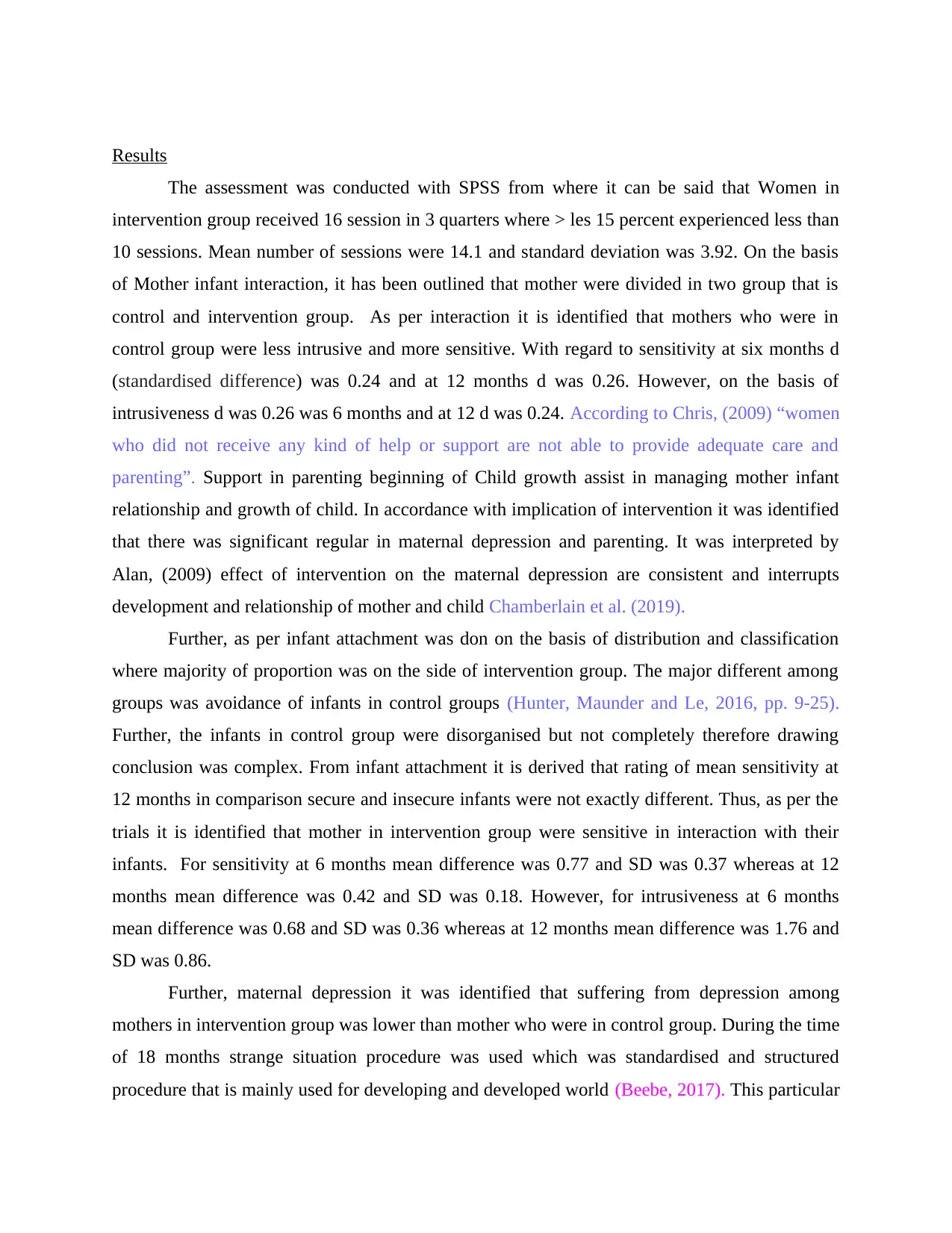
Results
The assessment was conducted with SPSS from where it can be said that Women in
intervention group received 16 session in 3 quarters where > les 15 percent experienced less than
10 sessions. Mean number of sessions were 14.1 and standard deviation was 3.92. On the basis
of Mother infant interaction, it has been outlined that mother were divided in two group that is
control and intervention group. As per interaction it is identified that mothers who were in
control group were less intrusive and more sensitive. With regard to sensitivity at six months d
(standardised difference) was 0.24 and at 12 months d was 0.26. However, on the basis of
intrusiveness d was 0.26 was 6 months and at 12 d was 0.24. According to Chris, (2009) “women
who did not receive any kind of help or support are not able to provide adequate care and
parenting”. Support in parenting beginning of Child growth assist in managing mother infant
relationship and growth of child. In accordance with implication of intervention it was identified
that there was significant regular in maternal depression and parenting. It was interpreted by
Alan, (2009) effect of intervention on the maternal depression are consistent and interrupts
development and relationship of mother and child Chamberlain et al. (2019).
Further, as per infant attachment was don on the basis of distribution and classification
where majority of proportion was on the side of intervention group. The major different among
groups was avoidance of infants in control groups (Hunter, Maunder and Le, 2016, pp. 9-25).
Further, the infants in control group were disorganised but not completely therefore drawing
conclusion was complex. From infant attachment it is derived that rating of mean sensitivity at
12 months in comparison secure and insecure infants were not exactly different. Thus, as per the
trials it is identified that mother in intervention group were sensitive in interaction with their
infants. For sensitivity at 6 months mean difference was 0.77 and SD was 0.37 whereas at 12
months mean difference was 0.42 and SD was 0.18. However, for intrusiveness at 6 months
mean difference was 0.68 and SD was 0.36 whereas at 12 months mean difference was 1.76 and
SD was 0.86.
Further, maternal depression it was identified that suffering from depression among
mothers in intervention group was lower than mother who were in control group. During the time
of 18 months strange situation procedure was used which was standardised and structured
procedure that is mainly used for developing and developed world (Beebe, 2017). This particular
The assessment was conducted with SPSS from where it can be said that Women in
intervention group received 16 session in 3 quarters where > les 15 percent experienced less than
10 sessions. Mean number of sessions were 14.1 and standard deviation was 3.92. On the basis
of Mother infant interaction, it has been outlined that mother were divided in two group that is
control and intervention group. As per interaction it is identified that mothers who were in
control group were less intrusive and more sensitive. With regard to sensitivity at six months d
(standardised difference) was 0.24 and at 12 months d was 0.26. However, on the basis of
intrusiveness d was 0.26 was 6 months and at 12 d was 0.24. According to Chris, (2009) “women
who did not receive any kind of help or support are not able to provide adequate care and
parenting”. Support in parenting beginning of Child growth assist in managing mother infant
relationship and growth of child. In accordance with implication of intervention it was identified
that there was significant regular in maternal depression and parenting. It was interpreted by
Alan, (2009) effect of intervention on the maternal depression are consistent and interrupts
development and relationship of mother and child Chamberlain et al. (2019).
Further, as per infant attachment was don on the basis of distribution and classification
where majority of proportion was on the side of intervention group. The major different among
groups was avoidance of infants in control groups (Hunter, Maunder and Le, 2016, pp. 9-25).
Further, the infants in control group were disorganised but not completely therefore drawing
conclusion was complex. From infant attachment it is derived that rating of mean sensitivity at
12 months in comparison secure and insecure infants were not exactly different. Thus, as per the
trials it is identified that mother in intervention group were sensitive in interaction with their
infants. For sensitivity at 6 months mean difference was 0.77 and SD was 0.37 whereas at 12
months mean difference was 0.42 and SD was 0.18. However, for intrusiveness at 6 months
mean difference was 0.68 and SD was 0.36 whereas at 12 months mean difference was 1.76 and
SD was 0.86.
Further, maternal depression it was identified that suffering from depression among
mothers in intervention group was lower than mother who were in control group. During the time
of 18 months strange situation procedure was used which was standardised and structured
procedure that is mainly used for developing and developed world (Beebe, 2017). This particular
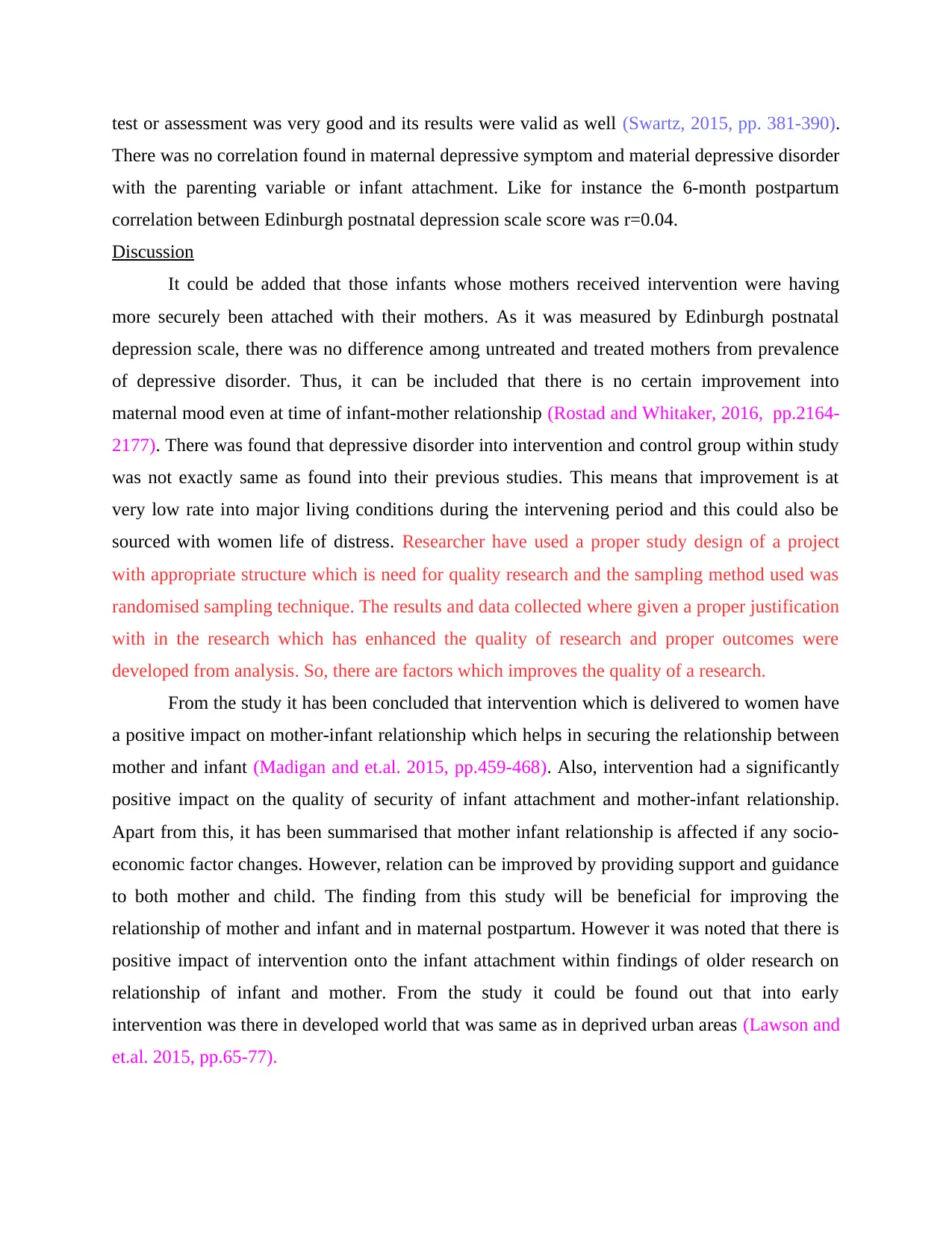
test or assessment was very good and its results were valid as well (Swartz, 2015, pp. 381-390).
There was no correlation found in maternal depressive symptom and material depressive disorder
with the parenting variable or infant attachment. Like for instance the 6-month postpartum
correlation between Edinburgh postnatal depression scale score was r=0.04.
Discussion
It could be added that those infants whose mothers received intervention were having
more securely been attached with their mothers. As it was measured by Edinburgh postnatal
depression scale, there was no difference among untreated and treated mothers from prevalence
of depressive disorder. Thus, it can be included that there is no certain improvement into
maternal mood even at time of infant-mother relationship (Rostad and Whitaker, 2016, pp.2164-
2177). There was found that depressive disorder into intervention and control group within study
was not exactly same as found into their previous studies. This means that improvement is at
very low rate into major living conditions during the intervening period and this could also be
sourced with women life of distress. Researcher have used a proper study design of a project
with appropriate structure which is need for quality research and the sampling method used was
randomised sampling technique. The results and data collected where given a proper justification
with in the research which has enhanced the quality of research and proper outcomes were
developed from analysis. So, there are factors which improves the quality of a research.
From the study it has been concluded that intervention which is delivered to women have
a positive impact on mother-infant relationship which helps in securing the relationship between
mother and infant (Madigan and et.al. 2015, pp.459-468). Also, intervention had a significantly
positive impact on the quality of security of infant attachment and mother-infant relationship.
Apart from this, it has been summarised that mother infant relationship is affected if any socio-
economic factor changes. However, relation can be improved by providing support and guidance
to both mother and child. The finding from this study will be beneficial for improving the
relationship of mother and infant and in maternal postpartum. However it was noted that there is
positive impact of intervention onto the infant attachment within findings of older research on
relationship of infant and mother. From the study it could be found out that into early
intervention was there in developed world that was same as in deprived urban areas (Lawson and
et.al. 2015, pp.65-77).
There was no correlation found in maternal depressive symptom and material depressive disorder
with the parenting variable or infant attachment. Like for instance the 6-month postpartum
correlation between Edinburgh postnatal depression scale score was r=0.04.
Discussion
It could be added that those infants whose mothers received intervention were having
more securely been attached with their mothers. As it was measured by Edinburgh postnatal
depression scale, there was no difference among untreated and treated mothers from prevalence
of depressive disorder. Thus, it can be included that there is no certain improvement into
maternal mood even at time of infant-mother relationship (Rostad and Whitaker, 2016, pp.2164-
2177). There was found that depressive disorder into intervention and control group within study
was not exactly same as found into their previous studies. This means that improvement is at
very low rate into major living conditions during the intervening period and this could also be
sourced with women life of distress. Researcher have used a proper study design of a project
with appropriate structure which is need for quality research and the sampling method used was
randomised sampling technique. The results and data collected where given a proper justification
with in the research which has enhanced the quality of research and proper outcomes were
developed from analysis. So, there are factors which improves the quality of a research.
From the study it has been concluded that intervention which is delivered to women have
a positive impact on mother-infant relationship which helps in securing the relationship between
mother and infant (Madigan and et.al. 2015, pp.459-468). Also, intervention had a significantly
positive impact on the quality of security of infant attachment and mother-infant relationship.
Apart from this, it has been summarised that mother infant relationship is affected if any socio-
economic factor changes. However, relation can be improved by providing support and guidance
to both mother and child. The finding from this study will be beneficial for improving the
relationship of mother and infant and in maternal postpartum. However it was noted that there is
positive impact of intervention onto the infant attachment within findings of older research on
relationship of infant and mother. From the study it could be found out that into early
intervention was there in developed world that was same as in deprived urban areas (Lawson and
et.al. 2015, pp.65-77).
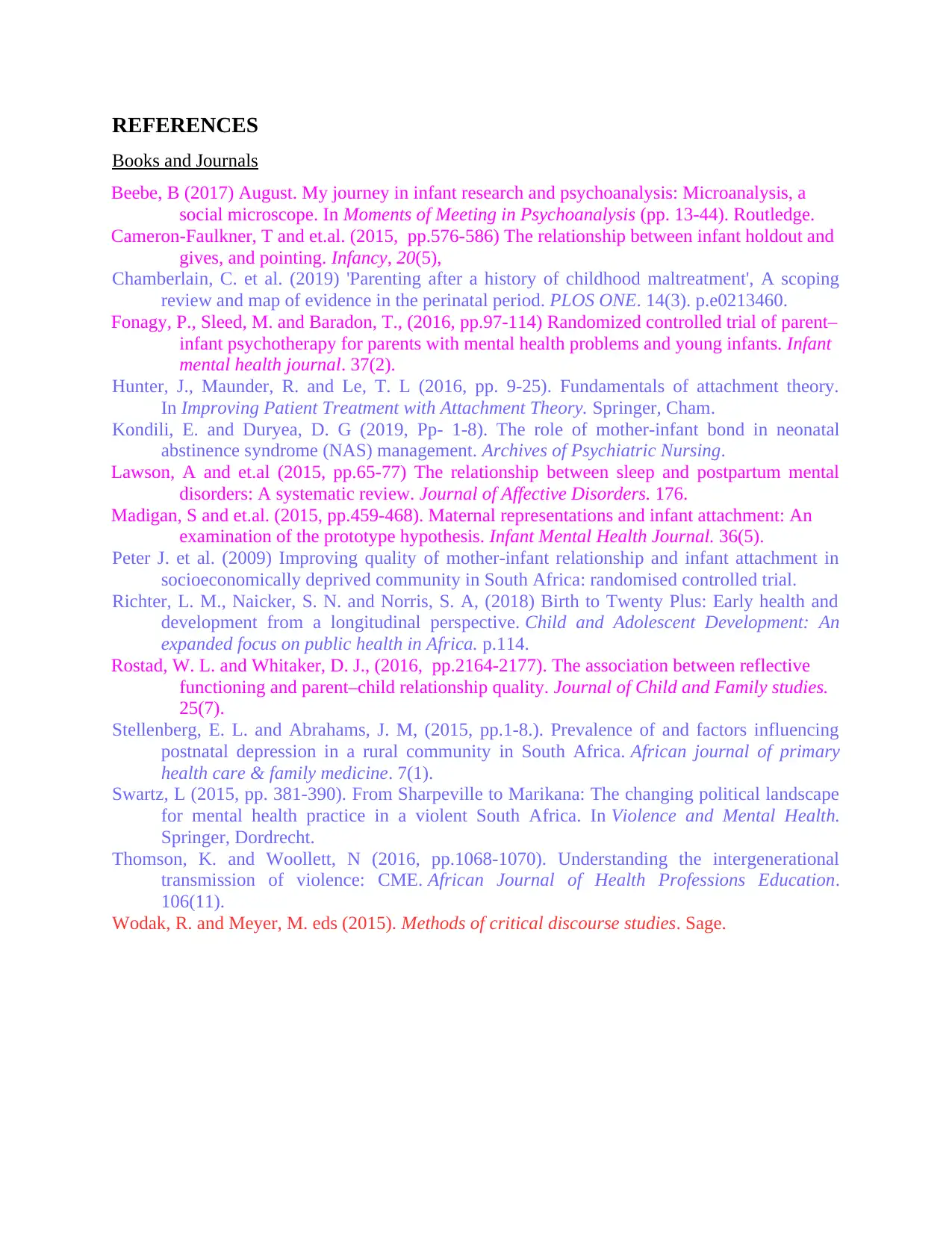
REFERENCES
Books and Journals
Beebe, B (2017) August. My journey in infant research and psychoanalysis: Microanalysis, a
social microscope. In Moments of Meeting in Psychoanalysis (pp. 13-44). Routledge.
Cameron‐Faulkner, T and et.al. (2015, pp.576-586) The relationship between infant holdout and
gives, and pointing. Infancy, 20(5),
Chamberlain, C. et al. (2019) 'Parenting after a history of childhood maltreatment', A scoping
review and map of evidence in the perinatal period. PLOS ONE. 14(3). p.e0213460.
Fonagy, P., Sleed, M. and Baradon, T., (2016, pp.97-114) Randomized controlled trial of parent–
infant psychotherapy for parents with mental health problems and young infants. Infant
mental health journal. 37(2).
Hunter, J., Maunder, R. and Le, T. L (2016, pp. 9-25). Fundamentals of attachment theory.
In Improving Patient Treatment with Attachment Theory. Springer, Cham.
Kondili, E. and Duryea, D. G (2019, Pp- 1-8). The role of mother-infant bond in neonatal
abstinence syndrome (NAS) management. Archives of Psychiatric Nursing.
Lawson, A and et.al (2015, pp.65-77) The relationship between sleep and postpartum mental
disorders: A systematic review. Journal of Affective Disorders. 176.
Madigan, S and et.al. (2015, pp.459-468). Maternal representations and infant attachment: An
examination of the prototype hypothesis. Infant Mental Health Journal. 36(5).
Peter J. et al. (2009) Improving quality of mother-infant relationship and infant attachment in
socioeconomically deprived community in South Africa: randomised controlled trial.
Richter, L. M., Naicker, S. N. and Norris, S. A, (2018) Birth to Twenty Plus: Early health and
development from a longitudinal perspective. Child and Adolescent Development: An
expanded focus on public health in Africa. p.114.
Rostad, W. L. and Whitaker, D. J., (2016, pp.2164-2177). The association between reflective
functioning and parent–child relationship quality. Journal of Child and Family studies.
25(7).
Stellenberg, E. L. and Abrahams, J. M, (2015, pp.1-8.). Prevalence of and factors influencing
postnatal depression in a rural community in South Africa. African journal of primary
health care & family medicine. 7(1).
Swartz, L (2015, pp. 381-390). From Sharpeville to Marikana: The changing political landscape
for mental health practice in a violent South Africa. In Violence and Mental Health.
Springer, Dordrecht.
Thomson, K. and Woollett, N (2016, pp.1068-1070). Understanding the intergenerational
transmission of violence: CME. African Journal of Health Professions Education.
106(11).
Wodak, R. and Meyer, M. eds (2015). Methods of critical discourse studies. Sage.
Books and Journals
Beebe, B (2017) August. My journey in infant research and psychoanalysis: Microanalysis, a
social microscope. In Moments of Meeting in Psychoanalysis (pp. 13-44). Routledge.
Cameron‐Faulkner, T and et.al. (2015, pp.576-586) The relationship between infant holdout and
gives, and pointing. Infancy, 20(5),
Chamberlain, C. et al. (2019) 'Parenting after a history of childhood maltreatment', A scoping
review and map of evidence in the perinatal period. PLOS ONE. 14(3). p.e0213460.
Fonagy, P., Sleed, M. and Baradon, T., (2016, pp.97-114) Randomized controlled trial of parent–
infant psychotherapy for parents with mental health problems and young infants. Infant
mental health journal. 37(2).
Hunter, J., Maunder, R. and Le, T. L (2016, pp. 9-25). Fundamentals of attachment theory.
In Improving Patient Treatment with Attachment Theory. Springer, Cham.
Kondili, E. and Duryea, D. G (2019, Pp- 1-8). The role of mother-infant bond in neonatal
abstinence syndrome (NAS) management. Archives of Psychiatric Nursing.
Lawson, A and et.al (2015, pp.65-77) The relationship between sleep and postpartum mental
disorders: A systematic review. Journal of Affective Disorders. 176.
Madigan, S and et.al. (2015, pp.459-468). Maternal representations and infant attachment: An
examination of the prototype hypothesis. Infant Mental Health Journal. 36(5).
Peter J. et al. (2009) Improving quality of mother-infant relationship and infant attachment in
socioeconomically deprived community in South Africa: randomised controlled trial.
Richter, L. M., Naicker, S. N. and Norris, S. A, (2018) Birth to Twenty Plus: Early health and
development from a longitudinal perspective. Child and Adolescent Development: An
expanded focus on public health in Africa. p.114.
Rostad, W. L. and Whitaker, D. J., (2016, pp.2164-2177). The association between reflective
functioning and parent–child relationship quality. Journal of Child and Family studies.
25(7).
Stellenberg, E. L. and Abrahams, J. M, (2015, pp.1-8.). Prevalence of and factors influencing
postnatal depression in a rural community in South Africa. African journal of primary
health care & family medicine. 7(1).
Swartz, L (2015, pp. 381-390). From Sharpeville to Marikana: The changing political landscape
for mental health practice in a violent South Africa. In Violence and Mental Health.
Springer, Dordrecht.
Thomson, K. and Woollett, N (2016, pp.1068-1070). Understanding the intergenerational
transmission of violence: CME. African Journal of Health Professions Education.
106(11).
Wodak, R. and Meyer, M. eds (2015). Methods of critical discourse studies. Sage.
1 out of 7
Related Documents
Your All-in-One AI-Powered Toolkit for Academic Success.
+13062052269
info@desklib.com
Available 24*7 on WhatsApp / Email
![[object Object]](/_next/static/media/star-bottom.7253800d.svg)
Unlock your academic potential
© 2024 | Zucol Services PVT LTD | All rights reserved.





